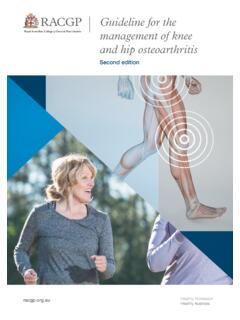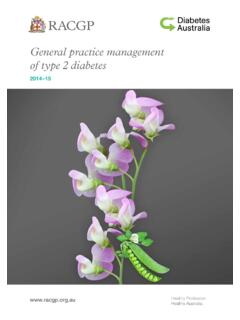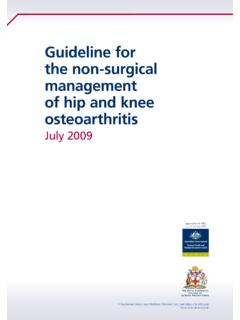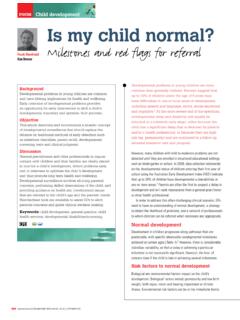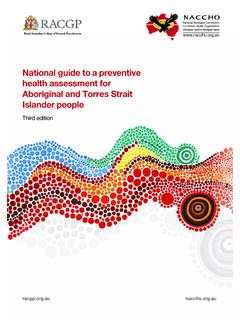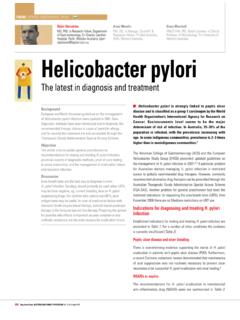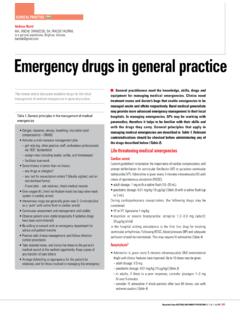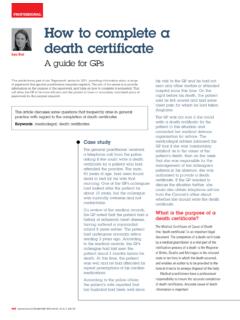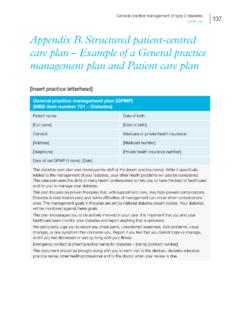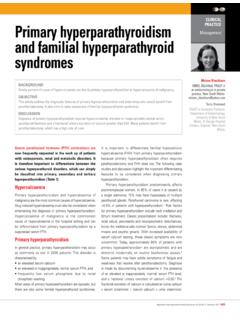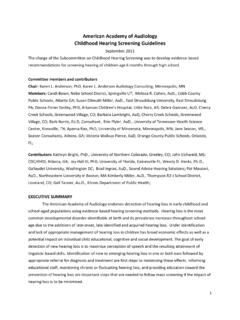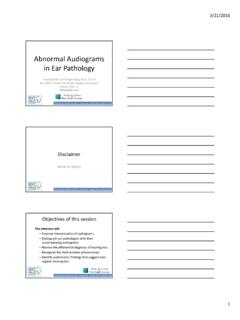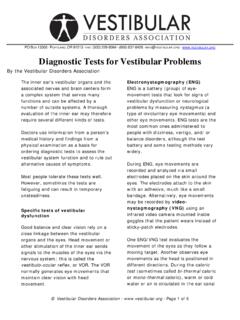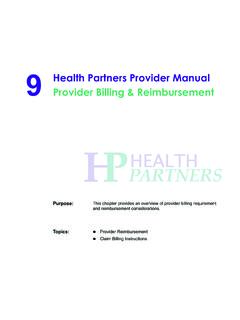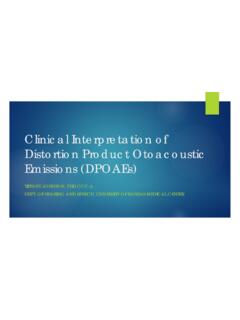Transcription of Asymmetrical hearing loss - Royal Australian College of ...
1 312 Reprinted from Australian FAmily PhysiciAn Vol. 37, No. 4, April 2008 thEmE ENT Vincent c cousins BMedSci, MBBS, FRACS, is Clinical Associate Professor, Monash University Department of Surgery, and an otologist-neurotologist, The Alfred Hospital, Melbourne, Prasad MBBS(Hons), is a surgical registrar, The Alfred Hospital, Melbourne, Victoria. loss is the most prevalent sensory deficit reported by patients. ten to 20% of Australians have some hearing impairment and approximately 50% of those over 65 years of age are hearing impaired. in 2005 2006, of all general practice encounters in Australia were for ear symptoms with an additional for vertigo and hearing loss can be conductive, sensorineural or mixed.
2 The most common type of hearing impairment in adults is Sensorineural hearing loss (SNHL) indicates defects in either the cochlea or in the neural transmission to the central nervous system. Table 1 demonstrates the wide range of possible aetiologies of SNHL. The more common causes of SNHL include presbycusis, noise induced hearing loss, Meniere disease, drug induced (ie. aminoglycosides) and infectious causes. Asymmetrical sensorineural hearing loss (ASNHL) is defined as binaural difference in bone conduction thresholds of >10 dB at two consecutive frequencies or >15 dB at one frequency ( kHz)3 (Figure 1). Poorer speech perception will often accompany poorer hearing and may be the reason for the patient s presentation.
3 A difference of >15% in the maximum speech discrimination score is also significant. An approach to patient presenting with AsnhlAsymmetrical sensorineural hearing loss may occur as a result of the common causes of bilateral sensorineural hearing loss such as age related or noise related hearing loss. However, ASNHL may also be: the only presenting symptom of a vestibular schwannoma or an intracranial tumour an indicator of another serious underlying pathological process such as an immune disorder or demyelinating disease, or associated with conditions such as idiopathic sudden SNHL or Meniere disease which may require specialist hearing lossBackgroundGeneral practitioners are usually the first point of contact for patients with hearing loss.
4 Asymmetrical sensorineural hearing loss can be a symptom of a wide range of diseases. A correct diagnosis is essential for appropriate treatment and limitation of the progression of hearing loss. ObjectiveThis article provides an outline for an approach to a patient presenting with Asymmetrical sensorineural hearing loss, and also provides a brief summary of four disease processes which may present with Asymmetrical hearing sensorineural hearing loss may be secondary to the process of aging or simply be related to excessive noise exposure. It can however, be the only presenting symptom of a vestibular schwannoma or an intracranial tumour. A high level of clinical suspicion is required to ensure that these pathologies are not missed. Reprinted from Australian FAmily PhysiciAn Vol.
5 37, No. 5, May 2008 313 Dual pathology is not uncommon in the causation of SNHL, and it is the asymmetry of the loss that may indicate an additional pathological process in the worse hearing ear. Therefore, the management of a patient with ASNHL requires a high level of clinical suspicion to ensure that these pathologies are not missed. Unilateral tinnitus, with or without associated hearing loss, has the same diagnostic implications as ASNHL. A detailed history can give valuable clues to the aetiology of the hearing loss. It is important to establish: the pattern of the hearing loss (unilateral or bilateral symptoms, progressive or stepwise, sudden or gradual in onset) associated symptoms such as tinnitus, aural fullness, vertigo, imbalance, otalgia and otorrhoea history of previous ear infections, noise exposure, otic barotrauma or ear surgery history of trauma to the ear or head previous intracranial surgery general health (conditions such as cerebrovascular disease, diabetes, other metabolic and autoimmune disorders can affect hearing ) family history of hearing loss or ear related tumours use of medications such as antibiotics (especially aminoglycosides)
6 , antimalarial drugs, anti-inflammatory agents (nonsteroidal anti-inflammatory agents [NSAIDs], salicylates), chemotherapeutic agents and diuretics. clinical examination The clinical examination includes examination of: the auricles skin lesions, pre-auricular sinuses, oedema, erythema, tragal tenderness external auditory canals mass lesion, discharge tympanic membranes colour, thickness, scarring, effusion, perforations head and neck cranial nerves, and postnasal space. Gross testing of hearing can be carried out using whisper tests. Tuning fork tests generally allow the physician to determine whether there is a conductive component to the hearing loss (Table 2). All patients with ASNHL require investigations including audiology and detailed diagnostic imaging (usually magnetic resonance imaging [MRI]) to determine aetiology.
7 In some cases various blood tests will assist. The clinical examination and history may often provide little help in differentiating patients with more common minor ear conditions from those with significant or sinister diagnosis. Cranial nerve palsies on examination are a worrying sign. All patients with ASNHL require specialist ear, nose and throat (ENT) referral and assessment due to the complex nature of the involved pathologies. It is preferable for this to happen within 6 weeks; but sooner if there are other associated neurological symptoms or 1. Examples of pathologies associated with SNHL hereditary and developmental Syndromic (1/3) Usher syndrome Pendred syndrome Alport syndrome Nonsyndromic (2/3) autosomal dominant inheritance autosomal recessive inheritance x lined or maternal mitochondrial cochlear otosclerosis Inner ear anomalies large vestibular aqueduct Cochlea anomalies Mondiniinfection* Meningitis, mumps, rubella, syphilis Other viral infectionsimmune disorders Systemic lupus erythromatosus Rheumatoid arthritis Polymyositis Ulcerative colitis Scleroderma HIVneurological Multiple sclerosis Cerebral ischaemia/stroke Migraine neoplasms* Benign Vestibular schwannomas (acoustic neuroma)
8 Meningiomas/other Malignant Local primary tumours Metastatic lesionsOtotoxins* Aminogylcosides Loop diuretics Quinine Chemotherapy agents (eg. cisplatin) NSAID ssystemic Paget disease Diabetes mellitus Hypertriglyceridemia/hypercholesterolemi atrauma* Noise induced Acoustic trauma Head injury Previous cranial/ear surgeryVascular/ haematological Coagulopathies Leukaemiaidiopathic* Presbycusis Meniere disease Idiopathic sudden sensorineural hearing loss* Indicates a more common/important conditionAsymmetrical hearing lossthEmEReprinted from Australian FAmily PhysiciAn Vol. 37, No. 5, May 2008 315 Signs of demyelinating lesions of central nervous system may also be identified with this technique.
9 The use of gadolinium contrast increases the sensitivity of this study. Computerised tomography (CT) scanning may be used if inner ear pathology or a developmental anomaly such as an inner ear dysplasia or large vestibular aqueduct is suspected. Computerised tomography scanning, preferably with the use of contrast, will also be used if an MRI is contraindicated such as when the patient has implanted electrical devices (cochlear implant, cardiac pacemaker) or a cerebral aneurysm Magnetic resonance imaging do not attract a Medicare rebate unless ordered by a specialist. If there are concerns about a major space occupying lesion, a contrast enhanced CT scan can be arranged early by the GP first to exclude any lesion > cm in maximum diameter.
10 If clear, then it is reasonable to wait for ENT , haematology, biochemistryHaematological, biochemical and serological tests may be useful in investigating hearing loss and choice of investigation will be determined by the history and examination findings. These include: fluorescent treponemal antibody for syphilis fasting blood sugar levels for diabetes erythrocyte sedimentation rate, antinuclear antibodies and rheumatoid factor in patients with a suspected immune cause of hearing Other specialised investigations such as haemolytic component and antiheat shock protein 70 antibodies5,6 are sometimes used in the specialist setting. An overview of four pathologies, which may present as ANSHL, is presented induced sensorineural hearing loss hearing impairment secondary to excessive noise exposure is one of the most common causes of new presentations with sensorineural hearing impairment7 and may account for approximately 30 50% of hearing loss presentations.
